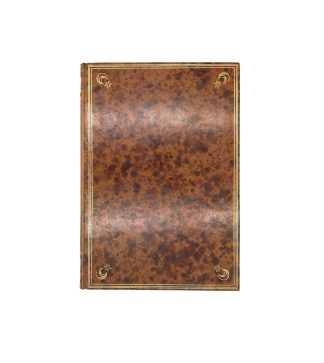BEDE, the Venerable.
De temporibus siue de sex aetatibus huius seculi liber incipit. P. Victoris De regionibus vrbis Rome libellus aureus.
Venice, p[er] Ioan. de Tridino alias Tacuino, anno Domini (die viii. Mai) 1509£3,950.00
4to. 50 unnumbered leaves, A-L⁴ M⁶. Roman letter. Fine white on black woodcut floriated and historiated initials, early manuscript marginal notes. Early ms. inked over on title with light stain through onto next leaf, slight age yellowing. A very good copy, crisp and clean in handsome speckled calf by Henry Young and Sons of Liverpool, covers bordered with a triple gilt rule, crescent moon and star gilt to corners (Bateman family device), spine with two compartments at head and tail with same device gilt, tan morocco label in long, gilt lettered, edges and inner dentelles gilt, a.e.g.
A beautifully printed edition of the Venerable Bede’s chronology of the six ages of the world taken from the De Temporum Ratione, his “Little book about the fleeting and wave-tossed course of time”, published for the first time in this form, in 1505 by the same publisher. ‘Some time ago I wrote two short books in a summary style which were, I judged, necessary for my students; these concerned the nature of things and the reckoning of time.’ Bede. “The Reckoning of Time is about measuring time and constructing a Christian calendar, or what later medieval writers called computus. It is the earliest comprehensive treatment of this subject, for though there was an abundant calendar literature before Bede’s day, it was both fragmentary and partisan in character… Bede’s book is very different in form and content..” Faith Wallis. ‘Bede the Reckoning of Time.’
In this edition is published a part only of the De Temporum Ratione, concerning the six ages of the world and its chronology. “Bede wrote about the chronological aspects of the six ages in De Temporum Ratione and De Temporibus, and also the Epistola ad Plegwinam. […] in chapter sixty-six [De Temporum Ratione], Bede compared the six ages of the world to the six ages of man, drawing on Augustine’s writings. This produces a somewhat different exegesis, portraying the world in a terminal decline towards death in the sixth age, … In chapter seventy-one, Bede likened the six ages to the days of the Lord’s passion and resurrection, which he also did elsewhere. The fact that Bede connected the six ages both to the days of creation and to the days of Holy Week suggests that the six ages formed a fundamental part of his concept of time, and of the relation of that time to his Christian faith.” Bede’s Commentary on the Six Days of Creation and the Six Ages of the World in In Genesim’
“The world ages scheme provided a historical framework for the biblical and post biblical events of the past and it also defined Bede’s perception of the present. According to the scheme outlined in De Temporibus, the present day fell within a sixth and final age of historical time which would end with the death of the whole world” Peter Darby ‘Bede and the End of Time.’
Appended to this edition is ‘De regionibus urbis Romae libellus aureus’ a literary forgery of the 15th century based on a IV century codex known as ‘Curiosum Urbis Romae regionum XIV’, represented as the work of a newly discovered author, Publius Victor. Both works were edited by Petrus Marenus Alexander, who signed the introductory epistles.
The binding has the device of the Bateman family and was most probably from the library of Thomas Bateman, who, like his father, William Bateman of Middleton by Yolgrave in Derbyshire, was an antiquary. Following in the footsteps of Pegge and Major Rooke, both father and son made excavations into several of the barrows in the Peak district. Thomas Bateman published three works on archaeology and built up a considerable museum and library. They were sold at Sotheby’s in 1893. cf. Toronto, British Armorial bindings.
BM STC It. C16th., p. 77. Cicognara 3910; Shaaber B405.In stock








